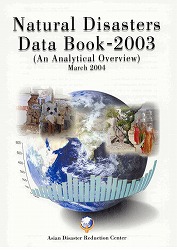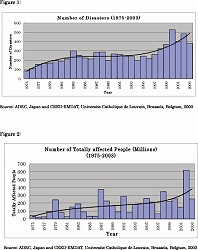Natural Disasters Data Book 2003

(An Analytical Overview) March 2004
foreword
 The year 2003 witnessed severe natural disasters occurred in the world. The highest death toll came from Iran Bam Earthquake, the highest affected population from the floods in China and the biggest economic damage from Korea Maemi typhoon. Africa also experienced severe earthquake in Algeria in 2003 which claimed heavy human loss and economic damages in the region. Further unexpectedly, Europe experienced severe high temperatures and heat waves which claimed heavy human loss and sufferings in the region. America also experienced severe storms affecting many people. These incidences once again drew the attention of the crisis managers and policy planners to the need of Total Disaster Risk Management Approach and reducing the vulnerabilities of these regions.
The year 2003 witnessed severe natural disasters occurred in the world. The highest death toll came from Iran Bam Earthquake, the highest affected population from the floods in China and the biggest economic damage from Korea Maemi typhoon. Africa also experienced severe earthquake in Algeria in 2003 which claimed heavy human loss and economic damages in the region. Further unexpectedly, Europe experienced severe high temperatures and heat waves which claimed heavy human loss and sufferings in the region. America also experienced severe storms affecting many people. These incidences once again drew the attention of the crisis managers and policy planners to the need of Total Disaster Risk Management Approach and reducing the vulnerabilities of these regions.
It is quite evident that the prevalence and magnitude of natural disasters have had serious consequences on human society and the global economy. The detrimental consequences of disasters on the societies in various aspects such as the economy, environment, and even adverse effects on national political agendas cannot be neglected. Also the frequency and the severity of natural disasters have notably increased worldwide. The exponentially increasing economic losses associated with natural hazards in the developing countries considerably obstruct the phase of development. This situation is further aggravated by the weak regional risk-transfer system. Hence the devastation caused by natural disasters has adverse effects on the ability of developing countries associated with economic uncertainties to compete in the global economy. When we look at the statistics for the last hundred years, it is clear that Asia is the most highly disaster afflicted region in the world, with about 90% of the totally affected people, and over 50% of the total deaths and total economic losses respectively. Hence, it is imperative to analyze past disasters, looking at annual trends from the perspective of development mechanisms.
With the aim of accelerating and strengthening global and regional socio-economic frameworks for addressing the consequences of natural disasters and designing effective disaster reduction mechanisms, we have edited this publication to analyze trends in the occurrence of natural disasters in the year 2003. We hope this publication will be of use not only to policy planners,researchers and academics but also to grass root level participants in development initiatives. We sincerely hope that this data book furthers our efforts to transform the total disaster risk management approach into an instrument for global sustainable development.
March 2005
Masayuki Kitamoto
Executive Director
Asian Disaster Reduction Center
Contents
Chapter 1 Impact of Natural Disasters
1-1 Trend of Natural Disaster Damage and Characteristics
1-3 Vulnerability of Countries with Small Economy and Population
Chapter 2 Natural Disasters and Sustainable Developmen
2-1 Human Development and Natural Disasters
2-2 Gender Issues and Natural Disaster Impact
2-3 Economics of Ntural Disaster Impact
Chapter 3 Rgional Characteristics of Natural Disasters
3-1 Population of Natural Disasters in the World Compare to Region
3-2 Regional Characteristics of Natural Disasters in the World
3-2-1 Chatacteristics of Disasters in Africa
3-2-2 Chatacteristics of Disasters in Americas
3-2-3 Chatacteristics of Disasters in Asia
3-2-4 Chatacteristics of Disasters in Europe
3-2-5 Chatacteristics of Disasters in Oceania
Chpter 4 Overview of Natural Disasters in Asia and ADRC Member Countries
4-1 Types of Disasters and their Effects in Asia and ADRC Member Countries
4-2 Asian and ADRC Member Countries and their Disaster Characteristics

